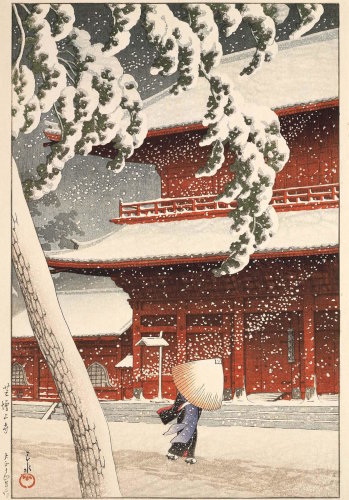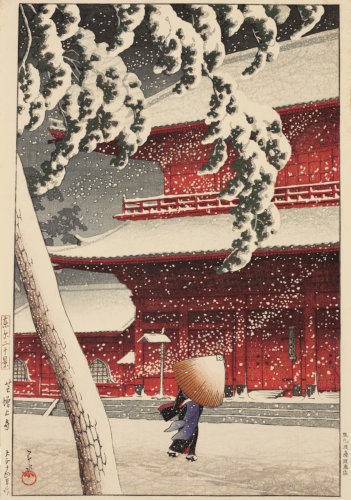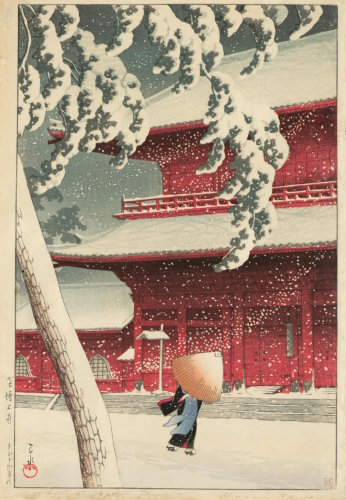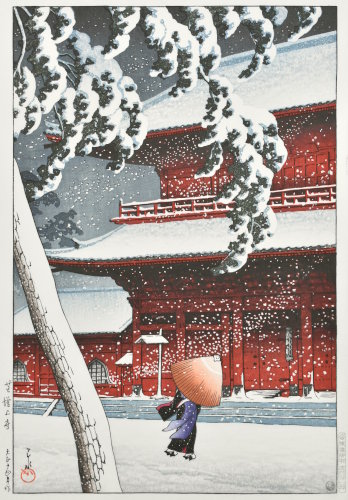States of Hasui's Zojoji Temple in Shiba 芝増上寺
This is speculative. It describes a sample of 137 prints. It may or may not describe the population of 3000 prints. The sequence was ordered on block use and abuse, and then seals and provenance.
Block wear appears to be consistent with Watanabe's seals and their placements. Seals do in fact appear to be indicative of age and this is perhaps because of high demand for this print. This point is important. Watanabe applied seals when prints were removed from inventory, not when an edition was printed so, in general for Watanabe-published prints, seals may not indicate when a print was actually made.
Colour variation in the kimono lining: The colour was pink until seq. 4. Generally afterward colour was the red pigment of the temple. The temple appeared darker against the lining because it had grey blocks layered on top.
Colour variation in the scarf: There was no indication that a blue scarf was earlier. In my reproduction, colour would alter from blueberry blue to coronation purple if pigment settled and wasn't frequently stirred. The ultramarine blue sank and the red floated in the bowl. Many original prints show the opalesque effect of blue and red pigments separating as a consequence of not being frequently stirred. Furthermore, as prints fade, the red usually fades at a faster rate enhancing the blue.
Colour variation in the temple: There was no indication that darker red or brick red temples were earlier. All prints were bright red before four layers of shadow and baren suji-zuri blocks were layered on top. In my reproduction, the red colour darkened throughout the batch. Firstly because a small amount of keyblock sumi transferred to the block on each impression darkening successive impressions. Secondly, when applying shadow blocks, for which darkness is very much at the discretion of the printer and difficult to consistently maintain, as pigment built in the block, later impressions off the block were darker, less of a bright red and closer to a dark rich red. As prints fade, the reds usually fade to a red-orange colour.
| Sequence | Printing Date | Frequency | Remarks | Example |
|---|---|---|---|---|
| 1 | 1925 | 4% | Round 6mm seal exclusively. These impressions showed the least wear. Undamaged keyblock and original colour blocks. The 6mm seal exclusively was consistent with other early Watanabe prints dating from 1924 and 1925. The seal was always seen in middle-left inside of the image. Two impressions had No 14 Hiyoshi-cho, Kyobashi-ku Tokyo address labels on versos indicating that they were sold between 1925 and 1929. Scholten Japanese Art also found an image of sequence 1 or 2 illustrated in The Studio: A Magazine of Fine and Applied Art, November 1927. Examples: Chazen 1980.749, MFA 35.1890, San Diego 1946.29.26 | 
|
| 2 | 1926 | 2% | Round 6mm seal with 'A' seal. Dual 6mm and 'A' seals was consistent with other early Watanabe prints in 1926. The 6mm seal was always seen in middle-left inside of the image with the 'A' seal nearby in the left margin. Examples: Christie's auction 2725 lot 602, Scholten 10-5786. | 
|
| 3 | 1926≤x≤1930 | 10% | 'A' seal in left margin. Impressions close to seq. 2 except for the absence of 6mm seal. | 
|
| 4 | 1926≤x≤1930 | 17% | 'A' seal in right margin. These impressions were close to seq. 3 although showed just a little more block wear. The keyblock lines on the stairs are starting to break. The kimono lining was now the colour of the temple in many impressions. Impressions from this seq onward generally showed weakly printed shadows under the lower roof, probably weak from a single printing impression. These shadows look like a grid pattern and required a double printing impresssion in my reproduction. This suggested that placement of seal changed over time and was not random. | 
|
| 5 | 1929≤x≤1930 | 5% | 'A' seal in right margin with series title cartouche. The introduction of the series title cartouche Twenty Views of Tokyo 東京二十景. Hasui scholar Hisao Shimizu proposed that the introduction of the series cartouche was late. This and other prints in the series very likely suggested a cartouche introduction in 1929. The Twenty Views of Tokyo series was not mentioned in the Toledo Catalogue (March 1930) nor do any prints in the Toledo collection show the series cartouche. Black ink cartouche stamp. | 
|
| 6 | 1930≤x≤1932 | 7% | 'B' seal with series title cartouche. The keyblock upper-right tree showed new damage not seen previously - something being dropped on it or it being dropped. The same area was damaged again midway through sequence - or was perhaps recarved into a more convincing leaf - confirming that prints with 'B' seal and series cartouche were all earlier than those without cartouche. Further confirmation of series cartouche being earlier from chip in keyblock right stair. Illustrated in Watanabe's 1936 Catalogue (April 1935). Sepia ink cartouche stamp. | 
|
| 7 | 1930≤x≤1932 | 2% | 'B' seal without series title cartouche. Caveat emptor: a post-war print sold recently at a major auction house with fake 'B' seal and without cartouche. | 
|
| 8 | 1931≤x≤1934 | 11% | 'C' seal with original colour blocks. The final state with wholly original blocks. Damage to keyblock extreme rooftip and keyblock top-left during seq. The majority of impressions in seq featured the 'C' seal, type 1 (colloquially referred to the Sausage seal). Type 1, based on this and other Watanabe prints, was 1931 to March 1933. A small minority of impressions featured the 'C' seal, type 2. Caveat emptor: the 'C' seal is the most commonly faked Watanabe seal including a Zojoji example that recently sold at a major auction house. | 
|
| 9 | 1934≤x≤1937 | 8% | 'D' seal with new umbrella block. New umbrella block. New block looked like a reproduction of the worn out original with deliberate and exaggerated embossing - not just a heavy baren (karazuri) but also the printer pressing paper down into the block with his fingers (kimedashi). The original umbrella block was never seen again. Early prints within sequence showed keyblock handrail was intact, later prints within sequence showed damaged handrail. The Osaka Mainichi reproduction (Dec 1934) reproduced the damaged handrail. After handrail was damaged, further keyblock damage to a sharp point top-centre and that too persisted hereafter. | 
|
| 10 | ≤1941 | 15% | 'D' seal with new blocks. New umbrella block and new scarf block. New blocks were quite different to original blocks. The original scarf block was never seen again. For reasons not entirely clear, the printers always looked after and washed blocks for the temple, but used and abused blocks for small colour areas. Increasing wear on keyblock just under top roofline. | 
|
| 11 | ≤1942 | 8% | 'C' seal with new blocks. More wear on keyblock just under top roofline and on the middle-left sky block than previous in sequence. Impressions in this sequence only featured the 'C' seal, type 2 (colloquially referred to as the Sausage seal). | 
|
| 12 | 1946 | 2% | Watanabe's personal seal. Seal always in bottom-right image. New black robe block. From now on use of very thick pigment, essentially gouache, which disguised that blocks were nearly unprintable. Gofun printed in the foreground, which its alkalinity prevents paper toning in the foreground. Provenance for the Watanabe's personal seal on Hasui prints was thanks to many US servicemen. | 
|
| =12 | ≥1946 | 3% | Postwar 6mm. Actually 6.5mm. Impressions indistinguishable from previous in sequence. Seal on lower-left outside of image or lower-right inside. | 
|
| =12 | ≥1946 | 6% | No seals. All prints seen without seals were post-war. All prints seen with older faked seals were post-war. | 
|
Reproductions
| Sequence | Date | Remarks | Example |
|---|---|---|---|
| 1 | Dec 5, 1934 | Osaka Mainichi. Published in Japan Today and Tomorrow, 1934 newspaper supplement, p144. Supplement read printed by Watanabe however Watanabe Shoichiro said it was not. The print replaced the original's baren sujizuri with blocks carved out with a U-gouge. The red appeared to be a water-soluble aniline dye that runs when wet. The unusual tool and dye make it very unlikely that this print was actually made in the Watanabe workshop. This print had very similar printing to Ito Shinsui and Kaburaki Kiyokata newspaper supplements of 1931 that used mechnically-printed keyblock lines with multiple woodblock sets for colours. They also used water-soluble dyes. Smaller than original, aiban, 33 x 22.5 cm. | 
|
| 2 | ≥2012 | Sakai Kokodo. Carved by Motoharu Asaka. Missing green leaves woodblock, temple shadow woodblock, and no baren sujizuri in foreground or on temple roofs. | 
|
| 3 | ≥2017 | Watanabe. Round 7mm seal, actually 7.3mm. Seal in margin reads copyright Watanabe Shoichiro. Well carved, but reproduced with gomazuri gradations in lieu of baren sujizuri. | 
|
| 4 | 2022 | Handcarved and handprinted from July to October 2022. Printed from 11 woodblocks in 37 impressions.

| 
|
updated